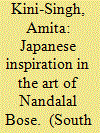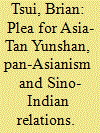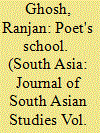|
|
|
Sort Order |
|
|
|
Items / Page
|
|
|
|
|
|
|
| Srl | Item |
| 1 |
ID:
187120


|
|
|
|
|
| Summary/Abstract |
This article explores the impact of Japanese art and its techniques on the work of Nandalal Bose (1882–1966), one of India’s pre-eminent artists, by locating specific influences from leading Japanese artists of his era, with whom he had close associations during his lifetime. It builds a case for the argument that despite being a staunch advocate for indigenous aesthetics, the depth and versatility of Nandalal’s artistic oeuvre was rooted in his ability to absorb select practices from other artistic cultures, specifically the Japanese, enabling us to connect the origins of India’s modernistic art practices principally to him. The article draws attention to the stylistic and ideological learning that he acquired during interactions with master artists from Japan, including Yokoyama Taikan, Hishida Shunsō and Arai Kanpō and demonstrates the significance of these Japanese influences to both Nandalal’s artistic life and, as a direct result, to the stylistic direction taken by Indian art in the mid-twentieth century.
|
|
|
|
|
|
|
|
|
|
|
|
|
|
|
|
| 2 |
ID:
108229


|
|
|
|
|
| Publication |
2010.
|
| Summary/Abstract |
In 1927, the Buddhist scholar, Tan Yunshan, travelled to Santiniketan on the invitation of Rabindranath Tagore to teach Chinese at Visva Bharati University. Subsequent years would see him develop close ties with the Guomindang and Congress leaders, secure Chinese state funding for the first sinological institute in India and mediate between the nationalist movements during the Second World War. That a relatively marginal academic, who participated in neither the May Fourth Movement nor any major political party, and who had little prior experience of India, could have played such an important role in twentieth century Sino-Indian relations raises questions over the conditions that made possible Tan's illustrious career. This article argues that Tan's success as an institution builder and diplomatic intermediary was attributable to his ideological affinity with the increasing disillusionment with capitalist modernity in both China and India, the shifting dynamics of the Pan-Asianist movement and the conservative turn of China's nationalist movement after its split with the communists in 1927. While Nationalist China and the Congress both tapped into the civilizational discourse that was supposed to bind the two societies together, the idealism Tan embodied was unable to withstand the conflict of priorities between nation-states in the emerging Cold War order.
|
|
|
|
|
|
|
|
|
|
|
|
|
|
|
|
| 3 |
ID:
110858


|
|
|
|
|
| Publication |
2012.
|
| Summary/Abstract |
This paper looks into the dynamics and performatives of Tagore's school which was established in 1901 at Bolpur in West Bengal. He called it Santiniketan. The paper critiques Tagore's notions of pedagogy in relation to the pregnant network linking the students, teachers and their natural environment; further, it investigates how the school has manifested itself as a green discourse and worked itself out within the dialectic of space and place, giving Tagore's ideas and the pragmatics of execution a fresh circulation of understanding. Here, for the first time, Tagore's ideas on education and nature (eco-pedagogy) are elaborately problematised through the intersections of a variety of thoughts and concepts drawn from contemporary ecocritical studies, ecosophy, discourses on nature, culture, and ethics of humane holism and bioegalitarianism.
|
|
|
|
|
|
|
|
|
|
|
|
|
|
|
|
|
|
|
|
|